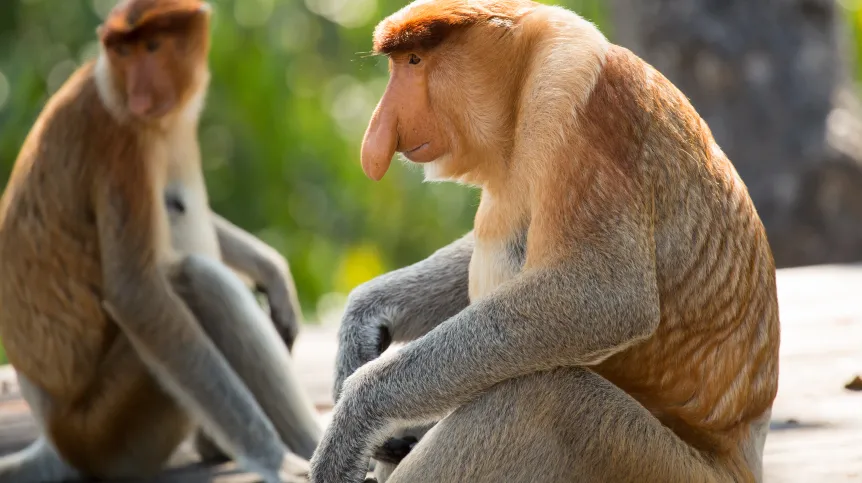
The image of a monkey with a long nose called Janusz, a typical Pole presented in memes, fits into the unfairly negative image of Poles created in the media after 1989, says Dr. Marek Kochan from SWPS University, who analysed memes featuring the proboscis monkey.
In his opinion, the behaviours presented by the monkey character can also be described as a strategy of resistance against the expansion of the free market, global brands and corporations.
Dr. Kochan analysed 354 memes featuring ‘Janusz the Proboscis Monkey - Typical Pole’. Proboscis refers to the long nose of a mammal. He looked at his values, habits, activities, adopted social roles, work, lifestyle (including consumer behaviour). The results were published in Przegląd Socjologiczny.
In the article, the author briefly presented catalogues of features used to describe the 'national character' and self-stereotypes of Poles, created in the past, from the 16th century to the first decades of the 21st century, after Poland joined the European Union. He then presented the functions of memes, including social critique.
‘The proboscis monkey character, created independently by hundreds of Internet users, is a surprisingly coherent construct', says Dr. Kochan.
He is most often presented as a husband and father, less often as a brother-in-law or son-in-law, and in fact he does not do well in any of these roles.
By profession, he is usually a driver, taxi driver, construction worker, manual worker, less often a small entrepreneur, only occasionally an intellectual.
The proboscis monkey from the memes is not wealthy, he lives in the province in a block of flats or a single-family house. 'An important feature is his generational affiliation: he grew up in the times of communist Poland, it can be estimated that he was born between 1955 and 1960. He often notices the passage of time, refers to the past of communist Poland as a utopia, an era when +things were better+’, a press release from the university says.
The proboscis monkey from the memes is a traditionalist, which is also reflected in the cuisine - he prefers traditional dishes, e.g. pork chop, he avoids novelties, including pizza. 'He definitely prefers eating at home than in a restaurant, usually to save money. If he does eat in public, he pretends to be a connoisseur, although in reality his taste is not very refined', the press release says. He does not care about the aesthetics of food, shows a lack of sophistication, he does not understand foreign names of dishes and cannot pronounce them.
Unfulfilled materialist, sale seeker
The proboscis monkey from the memes is an 'unfulfilled materialist'. 'He pays attention to the things people own and considers them to be the basis of self-esteem', Dr. Kochan says. He adds that 'his fetish is the car, a Volkswagen Passat, which returns in many memes as a symbol of financial status'. When shopping, the proboscis monkey, representing a typical Pole, ‘is rapacious, greedy, he tries to get as much as possible with limited funds: constantly looking for opportunities, sales'.
He prefers to spend his free time passively: for example, he would rather walk along Krupówki than hike in the mountains; he is not interested in culture.
'In his behaviour towards others, he is antisocial, focused on his own needs: if he shows any activity, it is in order to take care of his own business’, the press eels says. In addition, he does not know how to behave properly in public, he breaks rules and disrupts the rest of others. He is expansive and demanding.
He is also a noisy sports fan, initially enthusiastic, then ritually disappointed by failures ('you know, but you still hope').
Against consumerism and the dictatorship of brands?
According to Dr. Kochan, such a negative image of a Pole presented in the proboscis monkey memes is a manifestation of defence against a consumerist lifestyle and the dictatorship of global brands.
The features described in the memes can be compared to the so-called postcolonial identity, i.e. the idea of a community, e.g. an ethnic group, imposed by colonisers, and over time adopted as one's own. Such an image, usually excessively negative, served to justify conquest, legitimise foreign power and domination, discourage resistance and rebellion. In this case, the forces imposing the image are: the free market, global brands and corporations.
'The proboscis monkey character exists simultaneously on several typical axes of division: he is a representative of the province seen from the perspective of the metropolis, poor from the perspective of the rich, uneducated from the perspective of the educated and a loser of the transformation, mocked by the winners', says Dr. Kochan.
The behaviours of the proboscis monkey character, grotesquely exaggerated and ridiculed in memes, can therefore be described as a strategy of resistance against colonization, understood as the expansion of the free market, global brands and corporations. 'On the one hand, the proboscis monkey from the memes tries to maintain his own lifestyle (pork chop, homemade sandwiches), while on the other he manages limited resources, so he has to optimise purchases, take advantage of opportunities', the press release.
In the memes, the proboscis monkey defends himself against the colonizing pressure of the free market, consumerism, and brand propaganda: he looks for quality at a good price, tries to use domestic substitutes, limits expenses to the necessary, so as not to be pushed to the margins of a society that aggressively encourages consumption and stigmatises those who avoid it.
'His presence and popularity in public discourse in Poland can, on the other hand, be treated as a process in which the community wants to get closer to the ideal of the +West+ and, to this end, represses its own traits (perceived as negative) by translating them into an imaginary persona', says Dr. Kochan.
Source of stigmatisation and social divisions
However, in this image created in memes, the constitutive traits characteristic of Poles in previous decades are completely repressed or absent: patriotism, attachment to freedom, individualism, courage, bravery, honour, nobility, hospitality, gentleness, generosity. Some formerly positive traits, such as metaphysics, spirituality and religiosity, appear as caricatures.
Dr. Kochan says that the critical self-stereotype of a given community can fulfil a number of social functions. By stigmatising negatively rated behaviours or traits, it can encourage self-reflection and change. 'The proboscis monkey memes could fulfil this task if they stigmatised specific attitudes or individuals. However, when they function as a false and stereotypical construct of a +typical Pole+, the negative collective self-stereotype contained in them does so to a limited extent', he adds.
Stigmatisation of Poles through a negatively marked image can lead to social polarisation and division into those who distance themselves from Polishness (identifying with the senders of critical memes) and those who identify with Polishness - ridiculed in memes, who may feel like victims of symbolic violence because of this.
'If similar stereotypes concerned the inhabitants of Africa or any specific nationality (e.g. Syrians), they would immediately be met with accusations of racism', says Kochan. All the more so if a nationality was ridiculed in cultural texts and at the same time represented by a monkey: an animal close to humans, but still lower, non-human. 'Meanwhile, negative stereotypes about Poles, portrayed as monkeys and generalising negative behaviours of individuals to the entire population are tolerated - why exactly?’, he adds.
He points out that the tendency to mock the faults of one's own community could be evidence of its strength if it were a complement to a strong positive identity built on cultural texts or public discourse. 'Meanwhile, memes fit into the unfairly negative image of Poles created in the media after 1989, even if it changes slightly for the better over time’, Kochan says.
PAP - Science in Poland
amk/ agt/ kap/
tr. RL













